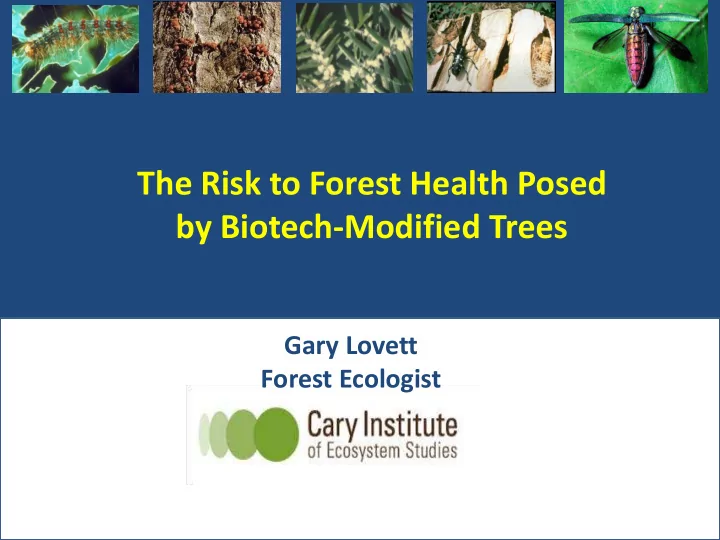

The Risk to Forest Health Posed by Biotech-Modified Trees Gary Lovett Forest Ecologist www.caryinstitute.org/tree-smart-trade
“Forest Health” A squishy but useful term • If it is to be quantified, best understood like human health, as a series of metrics that have a “normal” range* • Metrics must be readily measurable to be useful * With the understanding that some outliers can be outside the normal range but still “healthy”
Forest Ecosystem Health: Which Metrics? Metric Measurable index Primary productivity ANPP (wood growth + litterfall) or GPP (eddy covariance CO2 flux) Nutrient acquisition Foliar chemistry Mortality Mortality rate or standing dead trees Nutrient retention Leaching (soil water) Water use/evapotranspiration (Precip. – streamflow) or eddy covariance H2O flux Resilience to moderate stress Mortality after stress event Physical structure, age structure Direct measurement through forest inventory/ canopy and plant spp. composition assessment Food web structure Monitoring of animal populations Soil quality Forest floor mass and chemistry; soil chemistry
Imported Forest Pests: Ecological Impacts Introduced pests are the only threat that can reduce major canopy species to ecological insignificance in a matter of decades American chestnut Chestnut grove in North Carolina, ca. 1910 (Photo: Forest History Society, Durham, NC)
Impacts of Forest Pests Reverberate Though the Ecosystem Decline of old-growth forests, Death of trees release of invasive plants Hemlock Woolly Adelgid Warming of streams may Short- and long-term impact fish Decline of some bird changes in carbon storage species and nutrient losses (Photo: Barry Baldigo)
Forest Pests: Short- and Long-Term Effects Host tree species: Pest/pathogen Damage or death Long-term studies Chronosequence studies Modeling Feedbacks Forest species composition Feedback Forest ecosystem characteristics: Structure, productivity, nutrient cycling, food web Effects on embedded or adjacent ecosystems e.g., streams, lakes, wetlands Lovett et al. B ioscience 2006
Spe-CN: An ecosystem model with individual tree species • Simulates pools of C & N, Climate change Invasive pests Nitrogen emissions monthly time step • Changes in tree species Harvest Species parameterized by composition & abundance regime Temp. specific traits; e,g, foliar N, Precip. litter lignin, mycorrhizal type Carbon Nitrogen dioxide deposition • User sets scenarios: • Tree growth Rate & type of change in species composition • Litterfall N deposition regime • Available Harvest or nitrogen Decomposition & disturbance history in soil Soil C & N storage Carbon (C) • Nitrogen (N) Nitrate leaching to Assess effects of tree C & N lakes and streams species change on forest productivity, C storage, N retention/leaching Crowley et al. 2016 Forest Ecol & Mgmt Crowley & Lovett 2017 Can J For Res
Transition NO 3- leaching (g N m -2 y -1 ) begins 0.6 Bugwood.org 80% Ash harvest 0.4 Maple - leaching (g N m -2 y -1 ) 0.2 0.0 1800 2000 2200 2400 Loss of Catskills Year NO 3- leaching (g N m -2 y -1 ) Leaching - spp constant Leaching - spp transition 0.6 white ash due to Sp. constant Ash emerald ash borer, 0.4 Oak with replacement by 0.2 Sp. change different species 0.0 1800 2000 2200 2400 NO 3 Year NO 3- leaching (g N m -2 y -1 ) Leaching - spp constant Leaching - spp transition 0.6 Ash 0.4 Beech 0.2 0.0 1800 2000 2200 2400 2000 1800 2200 2400 Year Crowley & Lovett 2017 Can J For Res t n Year
What About Biotech Modified Trees? Host tree species: Pest/pathogen Damage or death Feedbacks X Forest species and trait composition Forest species composition Feedback Forest ecosystem characteristics: Structure, productivity, nutrient cycling, food web Effects on embedded or adjacent ecosystems e.g., streams, lakes, wetlands Lovett et al. B ioscience 2006
Modifying Plant Traits Plant survival strategies involve trade-offs among traits. • Plants generally have limited energy available, so they can’t do everything well. • If we modify plant traits for pest/disease resistance, we need to understand what traits are reduced or lost. Some traits are important to ecosystem function, for example: • Growth • Drought resistance • Seed production Traits can have indirect and unforeseen consequences “Nightmare scenarios” may be screened with field trials
What do we know about plant traits? • We have large global databases of plant traits • Models often use known relationships between traits and functions • But for many ecosystem functions, we lack knowledge about how they are influenced by plant traits • Plant performance and ecosystem function are often influenced by combinations of traits Word cloud from TRY global plant trait database https://www.try-db.org/TryWeb/Home.php
Conclusions and Research Needs • Impacts of modified trees are likely to be minor compared to impacts of pests • Forest ecosystem processes typically are resilient to mild to moderate stresses • Long-term impacts of introduction of biotech-modified trees can be modeled with trait-based models, particularly if we have o better knowledge of trait influences on ecosystem function o better knowledge of trait trade-offs in plants • Field studies involving experimental plantings in otherwise “natural” forests would be very instructive, and very helpful for modeling • We should increase our forest health monitoring, especially in areas where releases of modified trees are planned. Need to start prior to release to get a baseline. Key variables are understood and measurable.
Recommend
More recommend